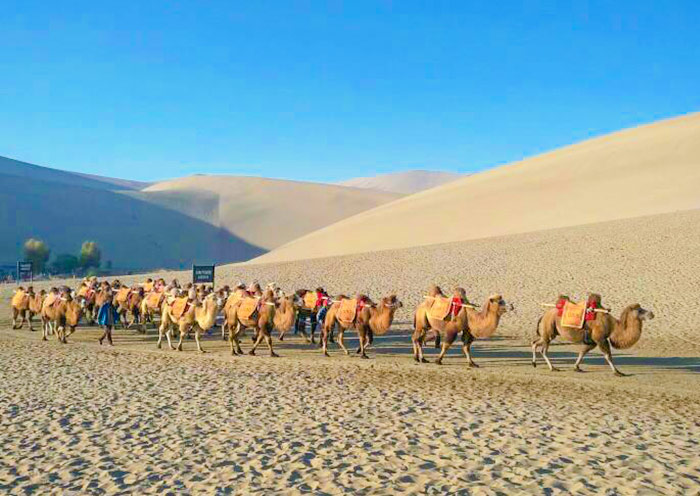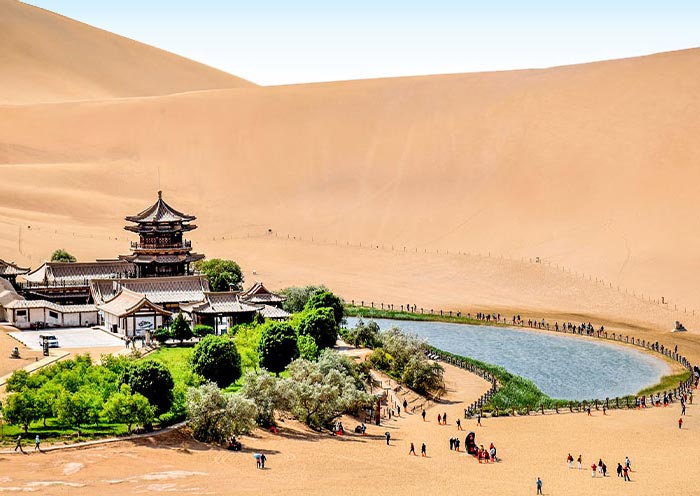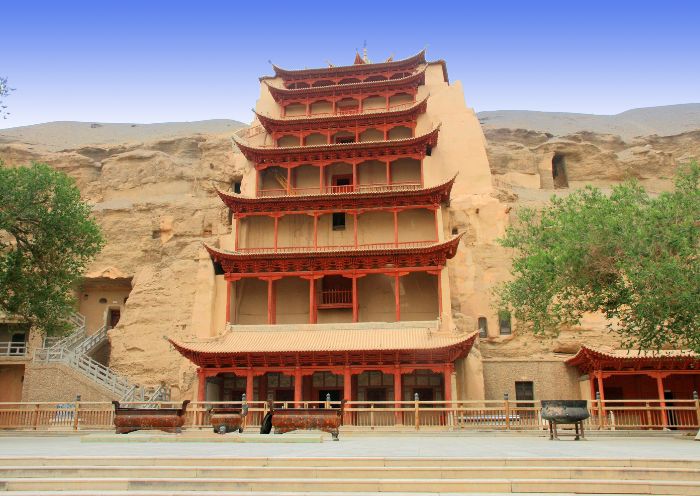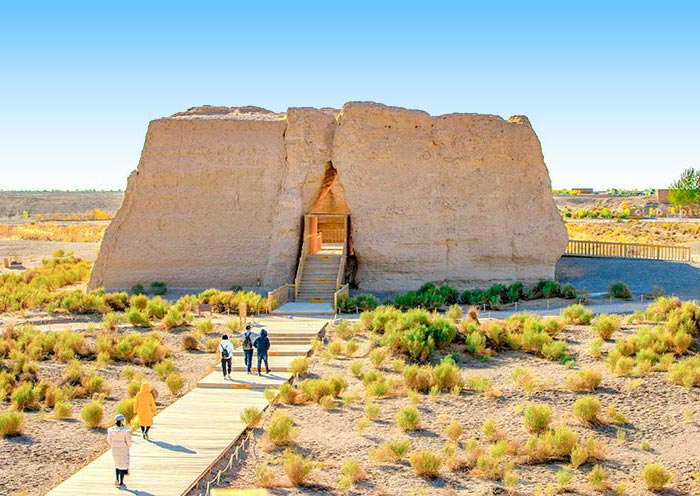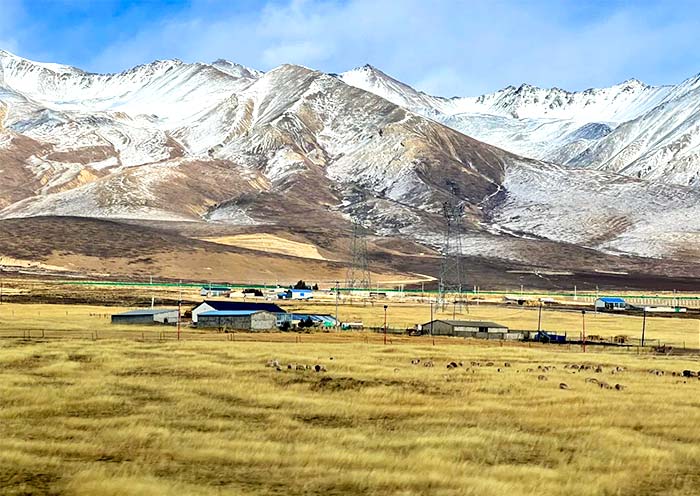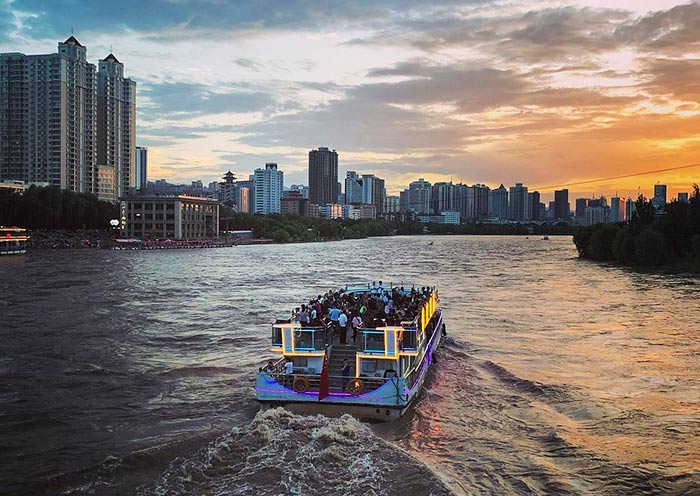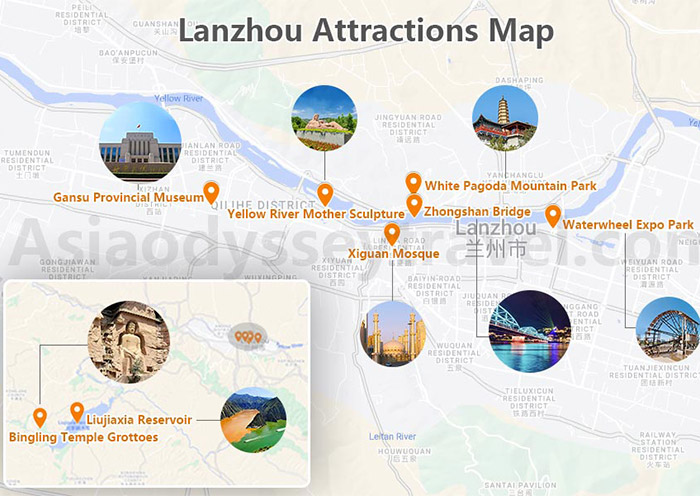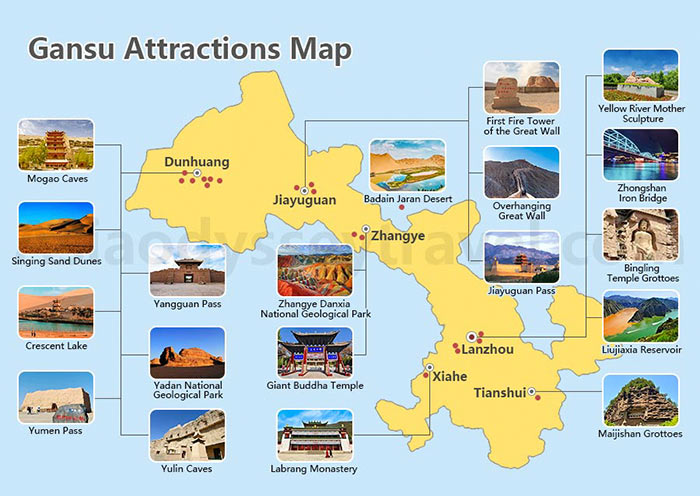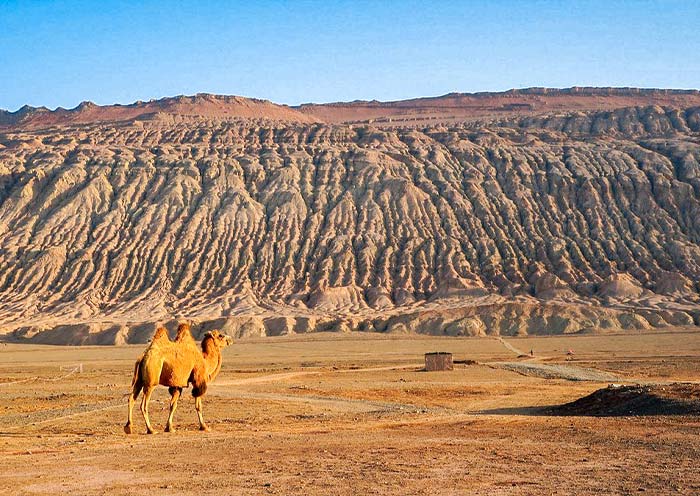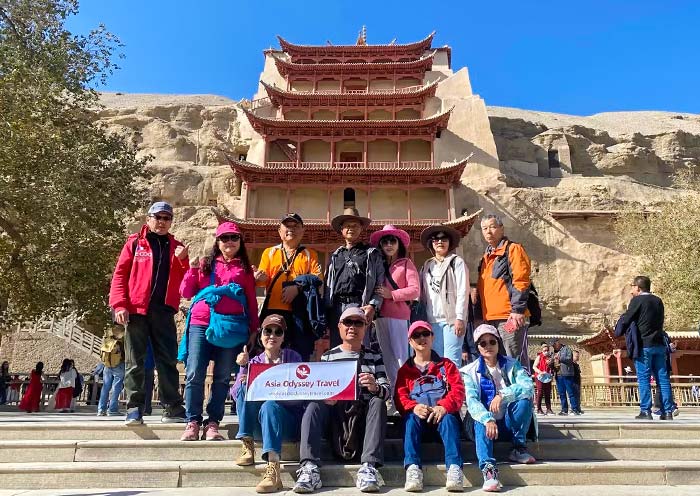Facts about Gansu
Chinese: 甘肃 (Gān sù)
Named for: Combine the first characters of two ancient prefectures, 甘州 (Ganzhou, now Zhangye) and 肃州 (Suzhou, now Jiuquan).
Area: About 454,000 square kilometers
Population: Around 25 million
Location: Northwest China, forming a crucial segment of the ancient Silk Road in China
Average Elevation: 1,500 to 3,000 meters
Climate: Semi-arid to arid zones account for 75% of Gansu, with cold winters and hot, dry summers.
Religion: Buddhism, Islam, Taoism, and traditional Chinese folk religions
Language: Predominantly Mandarin, with local dialects and minority languages such as Tibetan and Mongolian
Gansu Map with Key Attractions

Top Gansu Attractions: What to See in Gansu?
Discover the highlights of Gansu's attractions, both natural and cultural.
1. Dunhuang Mogao Caves
Known as the "Thousand Buddha Caves (千佛洞)," Dunhuang Mogao Caves (敦煌莫高窟) are a UNESCO World Heritage Site. The caves house exquisite Buddhist art, including murals and sculptures, dating back over a thousand years and showcasing ancient Chinese culture and spirituality.
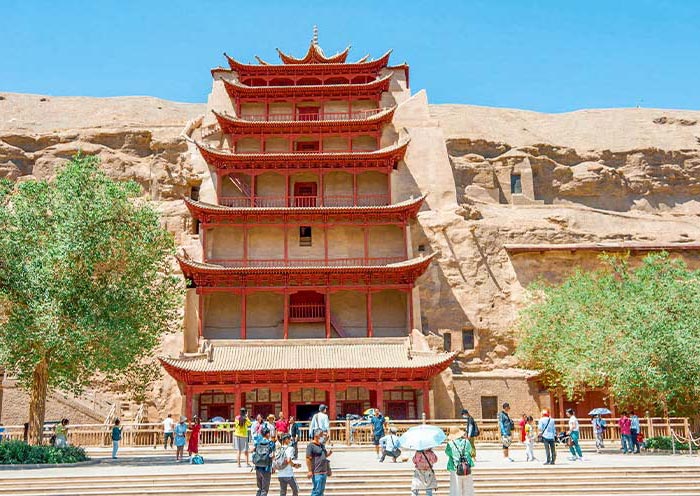
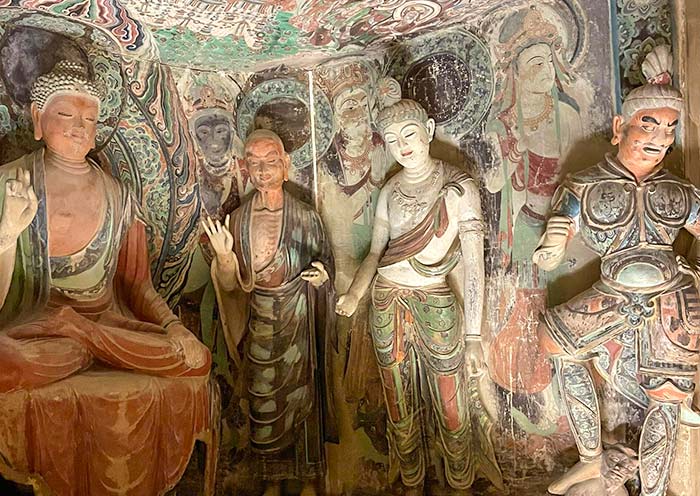
2. Mingsha Mountain and Crescent Moon Spring
Mingsha Mountain (鸣沙山), famous for its singing sands, surrounds the Crescent Moon Spring (月牙泉), a natural oasis in the Gobi Desert. This rare sight offers stunning desert landscapes and is ideal for camel rides and sunset views.
3. Jiayuguan Pass and Overhanging Great Wall
The Jiayuguan Pass (嘉峪关关城) marks the western end of the Great Wall and includes the unique Overhanging Great Wall (悬臂长城) built into steep cliffs. This ancient fortress once guarded the Silk Road, showcasing historic defense structures.
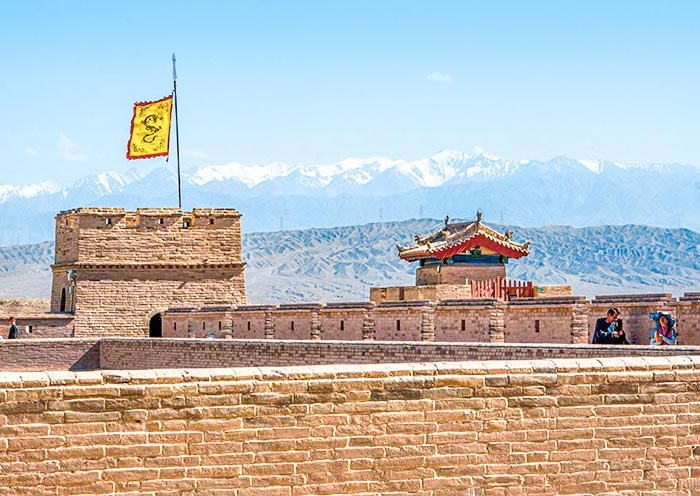

4. Zhangye National Geopark
Known for its stunning, multi-colored rock formations, Zhangye Danxia Geopark (张掖丹霞地质公园) is a natural wonder and popular photography spot. Its layered hues of red, orange, and yellow create a surreal, painterly landscape.
5. Liujiaxia Reservoir
Nestled along the Yellow River (黄河), Liujiaxia Reservoir (刘家峡水库) offers picturesque speedboat rides and is the gateway to the Bingling Temple Grottoes (炳灵寺石窟). The reservoir is ideal for water activities and exploring ancient Buddhist caves nearby.
Suggested Travel Length for Each Gansu City
Dunhuang (敦煌), Jiayuguan (嘉峪关), Zhangye (张掖), and Lanzhou (兰州) are the most popular destinations in Gansu.
Dunhuang (2-3 Days)
Located at the western end of the Hexi Corridor (河西走廊) in Gansu Province, Dunhuang is an important node on the ancient Silk Road, attracting tourists from all over the world with its rich cultural heritage and magnificent natural landscapes.
Here you can spend 2-3 days to explore the famous Mogao Grottoes, a UNESCO World Heritage, Singing Sand Dunes, Crescent Moon Spring, Shazhou Night Market, and Dunhuang Yardang National Geopark.

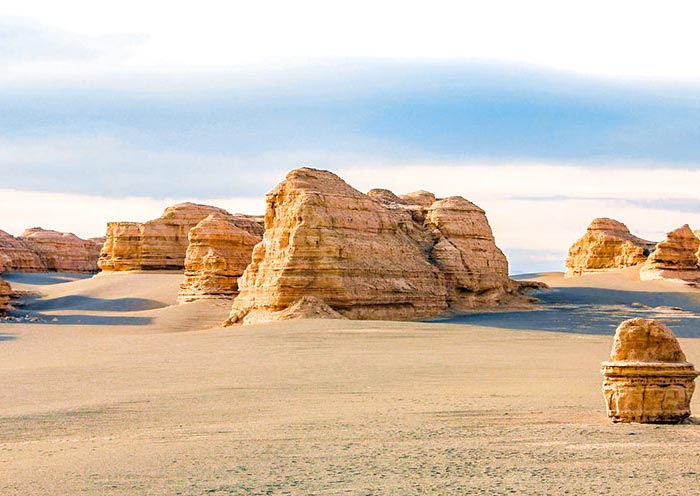
Jiayuguan (1 Day)
Jiayuguan Pass, located at the western end of the central part of the Hexi Corridor, is named after Jiayuguan Pass, which is the most important traffic hub of the ancient Silk Road.
Visit the Overhanging Great Wall and Jiayuguan Pass (World Heritage – the western end of the Great Wall of China). This takes 1 day.
Zhangye (1 Day)
Zhangye is one of the four counties established by Emperor Liuche (汉武帝) during the Han Dynasty in the Hexi Corridor.
Here you can discover the stunning landscapes of Zhangye National Geopark, also known as Zhangye Danxia Geological Park, and visit the Dafo Temple, also called Big Buddha Temple, for a rewarding day trip.

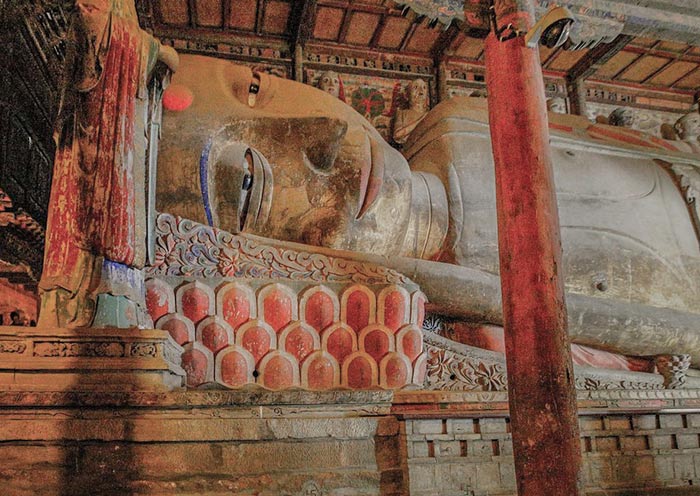
Lanzhou (1-2 Days)
Spend 1 day to see key Lanzhou’s landmarks like Zhongshan Bridge, White Pagoda Park, the Yellow River Mother Statue, and Waterwheel Park.
Or extend your exploration to the Liujiaxia Reservoir and take a speedboat to the Bingling Temple Grottoes, another UNESCO World Heritage Site near Lanzhou. This takes about 1 day.
How to Plan Your Gansu Travel Itinerary
Gansu Travel Itinerary 3 Days
If time is short, spend 3 days exploring Gansu's No.1 destination - Dunhuang, home to the famous Mogao Caves. In 3 days, you can explore the following Gansu attractions.
Attractions: Yumen Pass, Yardang Geopark, Mingsha Mountain and Crescent Moon Spring, Dunhuang Mogao Caves
Suggested Itinerary:
Day 1: Dunhuang Arrival - Free Time Explore
Day 2: Dunhuang Silk Road Tour - Yumen Pass, Yardang Geopark, Mingsha Mountain and Crescent Moon Spring (Sunset)
Day 3: Dunhuang Mogao Caves Tour, Dunhuang Departure - Mogao Grottoes
Gansu Travel Itinerary 6-7 Days
If you have a week to travel, consider a 6-7 day classic Gansu tour that covers the major destinations in Gansu, including Dunhuang, Jiayuguan, Zhangye and Lanzhou.
Attractions: Mogao Caves, Singing Sand Dunes, and Crescent Lake in Dunhuang, Jiayuguan Pass and Overhanging Great Wall, Zhangye Danxia Geopark and Dafo Temple, Lanzhou Zhongshan Bridge and nearby Liujiaxia Reservoir and Bingling Temple Grottoes.
Suggested Itinerary:
Day 1: Dunhuang Arrival - Free Time Explore
Day 2: Dunhuang Tour - Mogao Grottoes, Singing Sand Dunes & Crescent Spring
Day 3: Dunhuang to Jiayuguan - Overhanging Great Wall, Jiayuguan Pass
Day 4: Jiayuguan to Zhangye - Dafo Temple (Big Buddha Temple), Zhangye National Geopark (Zhangye Danxia Geological Park)
Day 5: Zhangye to Lanzhou Tour by High Speed Train - Zhongshan Bridge, White Pagoda Park, Yellow River Mother Statue, Waterwheel Park
Day 6: Lanzhou Departure - Liujiaxia Reservoir (Speedboat), Bingling Temple Grottoes
Gansu Travel Itinerary 8-10 Days
8-10 days allows you to have a panoramic view of Gansu. You can discover more hidden destinations in Gansu, like Xiahe, located in Gannan Tibetan Autonomous Prefecture.
Attractions: Mogao Grottoes, Singing Sand Dunes and Crescent Lake in Dunhuang, Jiayuguan Great Wall, Jiayuguan Fort, Zhangye National Geopark and Dafo Temple, Lanzhou Zhongshan Bridge and nearby Liujiaxia Reservoir and Bingling Temple Grottoes, Xiahe Labrang Monastery and Thangka Sunning Terrace.
Suggested Itinerary:
Day 1: Arrival in Dunhuang - Free time to explore
Day 2: Dunhuang Tour - Mogao Caves, Mingsha Mountain & Crescent Moon Spring
Day 3: Dunhuang to Jiayuguan - Overhanging Great Wall, Jiayuguan Pass
Day 4: Jiayuguan to Zhangye - Big Buddha Temple, Zhangye National Geopark (Danxia Geopark)
Day 5: Zhangye to Lanzhou by High-Speed Train - Zhongshan Bridge, White Pagoda Park, Yellow River Mother Statue, Waterwheel Park
Day 6: Lanzhou to Xiahe - Liujiaxia Reservoir (speedboat), Bingling Temple Grottoes
Day 7: Xiahe to Lanzhou - Labrang Monastery, Thangka Sunning Terrace
Day 8: Departure from Lanzhou

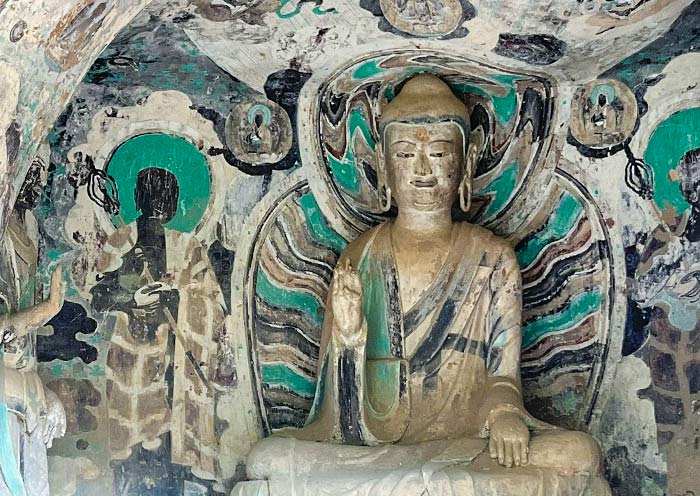
Gansu Weather: When Is the Best Time to Visit Gansu?
Gansu Weather
Gansu in northwest China has a dry, temperate continental climate with strong seasonal contrasts and regional variations. Annual temperatures range from 0°C to 16°C, with significant day-night temperature differences due to altitude.
- Dunhuang: Arid and warm, windy springs (dust storms in Mar-Apr), hot summers, cool autumn and cold winters. Annual average tempuratures is 9.4°C, with extremes from -30.5°C to 41.7°C.
- Jiayuguan: Dry, windy with minimal rain. Spring is windy, summers hot, winters cold, autumns cool, with average temperatures between 6.7°C and 7.7°C.
- Zhangye: Arid, warming fast in spring, warm summers with most rain in June/July, short autumns, long, cold winters. Annual temperatures: 4.1°C-8.3°C.
- Lanzhou: Mild, with warm summers (20°C) and cold winters (-4°C to 6°C), with an average annual temperature of 10.9°C - an ideal summer destination.
Best Time to Visit Gansu: May to October
May to October is the best time to visit Gansu, with warm temperatures averaging 20.8°C in summer, quickly cooling in autumn to 9.6°C. Prepare for big temperature differences across regions and from day to night.
July and August is the peak season for travelling in Gansu. There are more people and more expenses, and tickets, transport and hotels have to be booked in advance. If you consider travelling in a staggered way, then you can consider May or June or September or October.
November to April is great for budget travelers with fewest visitors, cheapest admission, and lowest accommodation costs. Snow-covered Gansu attractions like Mingsha Mountain, Crescent Lake in Dunhuang, and Zhangye Danxia Geopark are stunning. Keep warm in winter and protect yourself from the wind in spring!

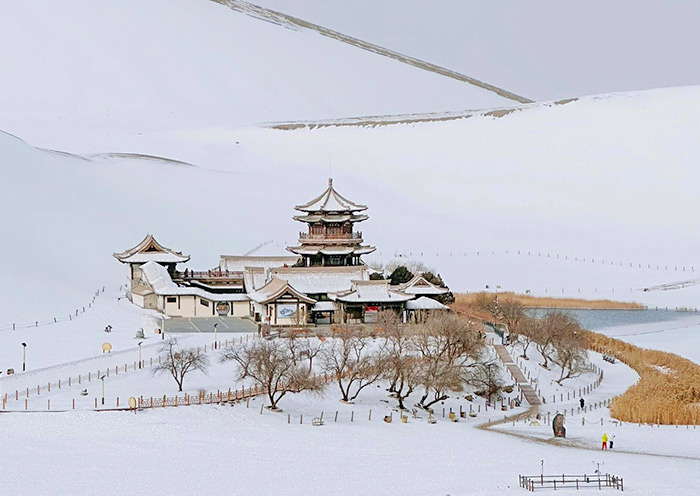
Gansu Transportation: How to Get to Gansu?
Get to Gansu by Air
Gansu has 2 international airports: Lanzhou Zhongchuan International Airport and Dunhuang Mogao International Airport, with domestic and some international routes.
- Fly to Lanzhou
Airport: Lanzhou Zhongchuan International Airport (兰州中川国际机场)
Location: 75 km from downtown Lanzhou
International flights to Lanzhou Zhongchuan International Airport mainly come from Hong Kong, Osaka, Singapore, Phuket, Pattaya, Nha Trang, Kuala Lumpur, Frankfurt, Dubai and so on. Domestic flights to Lanzhou come from Beijing, Shanghai, Hangzhou, Guangzhou, Shenzhen, Chengdu, Chongqing, Urumqi, Xi'an and so on.
- Fly to Dunhuang
Airport: Dunhuang Mogao International Airport (敦煌莫高国际机场)
Location: 12.7 km from the Dunhuang city and 15 km from Mogao Caves
Dunhuang Mogao International Airport offers international flights from Seoul and Hong Kong, China to Dunhuang, and flights from Beijing, Shanghai, Xi'an, Xining, Hangzhou, Chengdu, Chongqing, Guangzhou and Turpan to Dunhuang.
Get to Gansu by Train
Gansu has a well-developed rail network with major destinations accessible by high-speed rail.
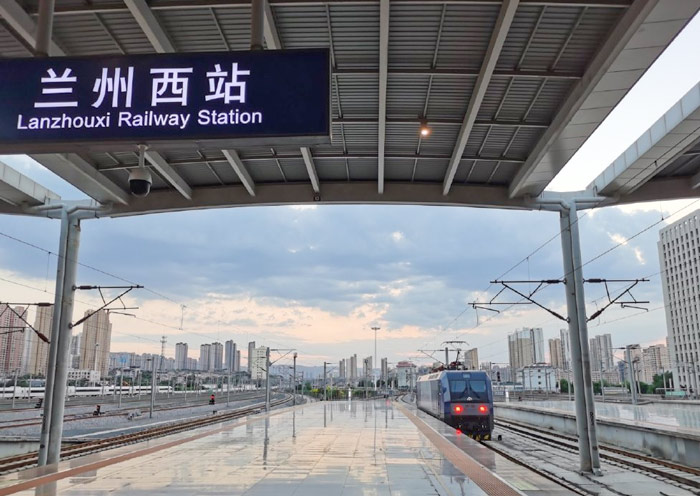
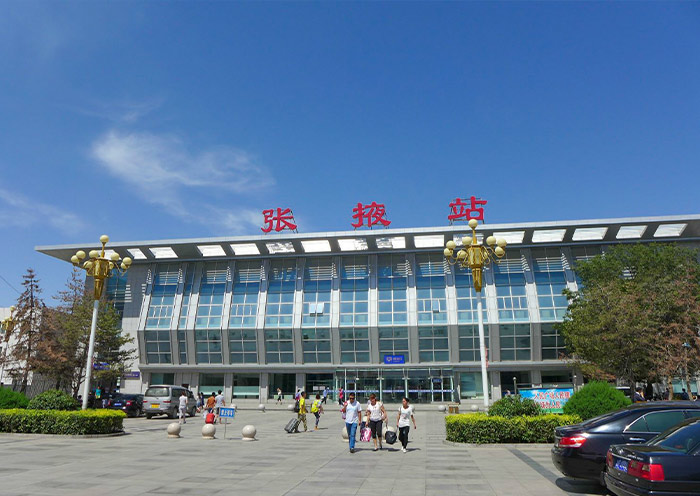
- Take a Train to Lanzhou
Railway Station: Lanzhou West Railway Station (兰州西站), Lanzhou Railway Station (兰州站)
Location: Up to 13 km from Lanzhou city center
Lanzhou is served by high-speed railways from Urumqi, Xining, Xi'an, Chongqing, Beijing, Shanghai, Guangzhou, etc. and from Dunhuang, Jiayuguan and Tianshui in Gansu.
- Take a Train to Zhangye
Railway Station: Zhangye West Railway Station (张掖西站)
Location: 40km from Zhangye Danxia Geological Park
Zhangye West Railway Station was built for the Lanzhou-Xinjiang High Speed Railway. You can take the high-speed train to Zhangye from Xi'an, Baoji, Tianshui, Lanzhou, Xining, Yumen, Turpan, Urumqi and other cities along the railway.
- Take a Train to Jiayuguan
Railway Station: Jiayuguan South Railway Station (嘉峪关南站)
Location: 9 km from Jiayuguan City, about 7 km from Jiayuguan Pass
Cities accessible by train to Jiayuguan South Railway Station include, but are not limited to Zhangye, Lanzhou, Urumqi, Xining and Jiuquan.
- Take a Train to Dunhuang
Railway Station: Liuyuan South Railway Station (柳园南站)
Location: About 130km from Dunhuang City, 150km from Dunhuang Mogao Grottoes
If you plan to take a high speed train to Dunhuang, Liuyuan South Station can be reached from Lanzhou, Xining, Zhangye, Jiuquan, Jiayuguan, Yumen, Hami, Turpan, Urumqi and other cities.
How to Get Around Gansu
Traveling within Gansu by train or car is the most convenient way. Self-driving offers flexibility to explore breathtaking scenery, from snow-capped mountains to desert landscapes. Travel with AOT >>
Here are some transport guides for your trip around Gansu:
- Dunhuang to Jiayuguan: By private car (4 hours)
- Lanzhou to Zhangye: By high-speed train (3 hours)
- Zhangye to Jiayuguan: By private car
- Lanzhou to Jiayuguan: High-speed train from Lanzhou to Zhangye first, then Zhangye to Jiayuguan by car
- Dunhuang to Jiayuguan: By car (3-3.5 hours)
Gansu Accommodation: Where to Stay in Gansu?
Gansu offers a range of accommodation options from budget hotels to upscale establishments. Choose hotels near attractions, close to public transportation, or with good dining nearby. Book ahead, as popular spots can fill up quickly during peak travel seasons.
Dunhuang
For Dunhuang, staying in the city center is convenient and more economical than booking near scenic spots, which are often booked up and pricey during peak seasons.
From the city, reaching the Mogao Caves and Mingsha Mountain & Crescent Spring is easy by taxi or public transportation, and you’ll also have quick access to explore Dunhuang’s local food scene.
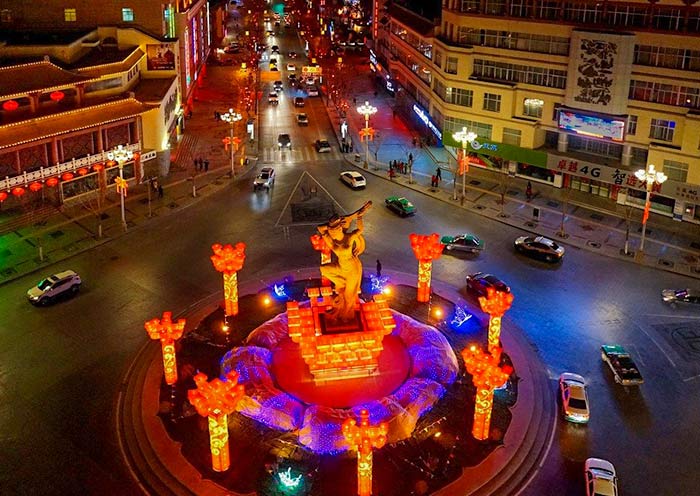
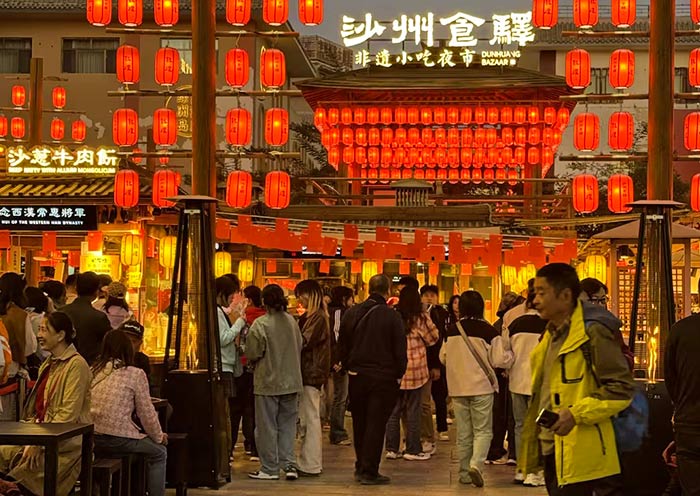
Jiayuguan
In Jiayuguan, we suggest staying near Fuqiang Market (富强市场), a well-known food hub with convenient access to Jiayuguan Pass and the Overhanging Great Wall via taxi or public transportation.
Zhangye
For Zhangye, staying in the old city center, especially near Bell Tower (钟鼓楼,又名靖远楼), with a bronze bell from the Tang Dynasty, is recommended. This location provides easy access to attractions like the Giant Buddha Temple and Zhangye Danxia National Geopark by bus or taxi.
Lanzhou
For Lanzhou, consider staying along Metro Line 1, which conveniently connects all the main attractions. Top picks are near Xiguan Station (西关站), Provincial Government Station (省政府站), and Dongfanghong Square (东方红广场站). Alternatively, consider the Qilihe (七里河站), Wulipu (五里铺站), and Lanzhou University stations (兰州大学站).
From Xiguan Station, you can walk to the Zhongshan Bridge, White Pagoda Park, and the Yellow River Cableway. Qilihe Station is close to the Gansu Provincial Museum, while Wulipu and Lanzhou University offer an authentic feel of local life and dining options.

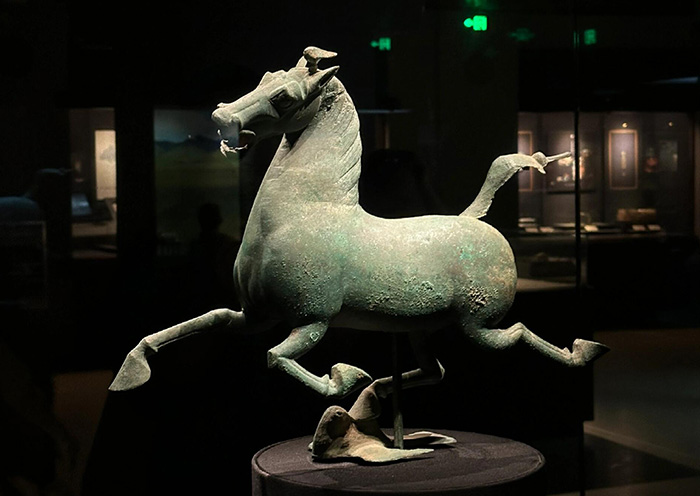
Must-Try Gansu Food: What Food Is Gansu Known for?
Gansu cuisine blends the flavors of various ethnic groups and displaying unique regional characteristics.
- Lanzhou Beef Noodles (兰州牛肉拉面): Famous for its clear soup, white radish, red chili oil, green cilantro, and yellow noodles.
- Grabbing Mutton (手抓羊肉): A Halal dish popular with the Hui ethnic group, known for its tender, juicy meat.
- Jingyuan Lamb (靖远羊羔肉): A specialty known for its delicate texture and unique cooking style.
- Tianshui Guagua (天水呱呱): Made from buckwheat starch, this traditional snack is soft and spicy.
- Longdong Hele Noodles (陇东饸饹面): A coarse-grain noodle dish featuring wheat, sorghum, and cornmeal.
- Sweet Fermented Wheats (甜醅子): A refreshing, fermented snack made from wheat or highland barley.
- Jiayuguan Grilled Meat (嘉峪关烤肉): Known for its rich seasoning that complements rather than overpowers the flavor of the meat.
- Gansu Malatang (甘肃麻辣烫): A variety of meats and vegetables, with potato noodles and chili oil as the essential elements.
- Apricot Peel Tea (杏皮茶): Brewed from apricot peels and offers a slightly tart sweetness.

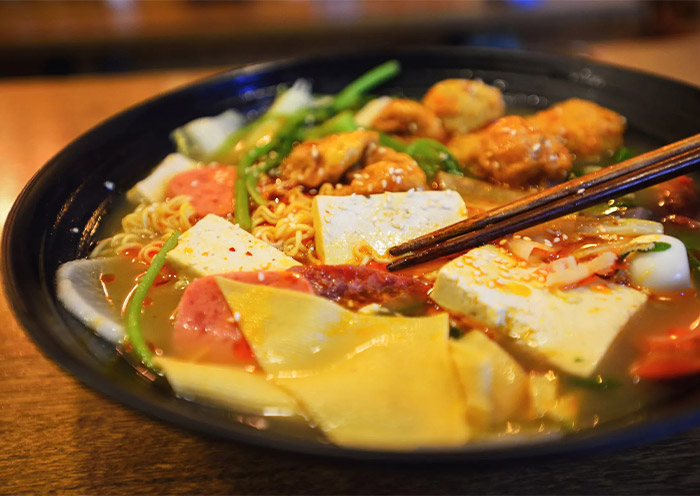
Insider Tips for Touring Gansu
- Gansu’s temperatures can vary greatly between day and night. Be sure to bring a jacket or windbreaker for cooler moments.
- Temperatures vary a lot from one area to another in Gansu. For instance, Dunhuang is really dry and hot in summer, while Zhangye has showers and Lanzhou is a summer resort.
- With Gansu's high elevation, UV rays are very strong, so sun protection is essential. Carry sunscreen, lip balm, sunglasses, and a sun hat.
- The climate in Gansu is also quite dry, so bring a water bottle, drink plenty of water, and consider eating fruit to stay hydrated.
- Due to the altitude, some visitors may experience mild altitude effects like headaches or dizziness. Don't worry—simply rest, avoid strenuous activity, and drink water to help alleviate symptoms.
- When visiting cultural sites like the Dunhuang Mogao Caves, please respect and protect the relics. Photography is not allowed, and avoid touching, carving, or marking the murals and sculptures.
Extend Your Gansu Trip into the Silk Road Journey in China
Gansu is a key stop on the ancient Silk Road in China, connecting Xinjiang and eventually reaching Central and West Asia and the Mediterranean countries.
If you have more time in China, retrace the ancient Silk Road of China and explore the rich and glittering cultural treasures and historical relics along the way. This is how you can spend your time:
- Gansu (3-10 Days):
Spend 3-10 days in Gansu to tour Dunhuang, Jiayuguan, Zhangye and Lanzhou, which are the key destinations in Gansu.
- Xinjiang (5-13 Days):
Spend 5-13 days in Xinjiang to view the diverse natural landscapes like Turpan Basin, Pamir Plateau (帕米尔高原), Baisha Lake (白沙湖), Taklamakan Desert (塔克拉玛干沙漠), and Karakul Lake (喀拉库勒湖) and a wealth of cultural heritages such as Kashgar Old City (喀什老城), Bezeklik Thousand Buddha Caves (柏孜克里克千佛洞), Jiaohe Ancient City Ruins (交河古城遗址), Karez System (坎儿井灌溉系统), Emin Minaret (苏公塔), Tashkurgan Fort (塔什库尔干古堡).
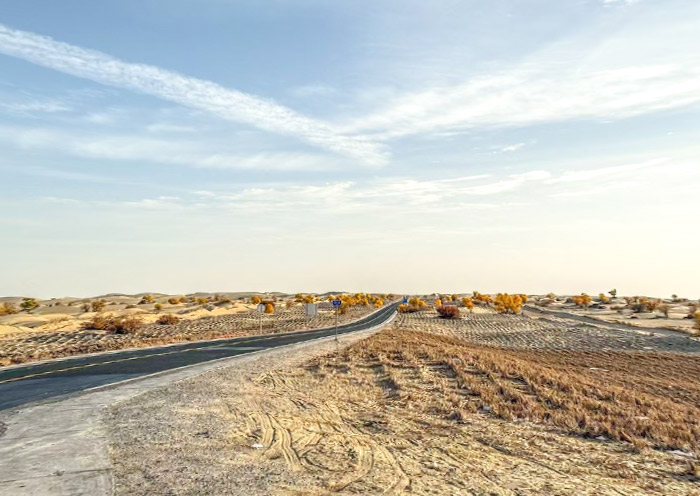

- Xi'an (3-4 Days):
Xi'an, ancient Chang'an (长安), is the beginning of the Silk Road in China. You can start your Silk Road tour from Xi’an and visit the Terracotta Army (秦始皇帝陵博物院), hike the Ancient City Wall (西安长城), and explore the Muslim Quarter (西安回民街) and Giant Wild Goose Pagoda (大雁塔).
- Beijing (3-4 Days):
If you start your China tour in Beijing, you can combine Beijing with your Silk Road tour. Spend 3-4 days in Beijing to visit the Mutianyu Great Wall (慕田峪长城), Bird's Nest (鸟巢) & Water Cube (水立方), Tian'anmen Square (天安门广场), Forbidden City (故宫) and Summer Palace (颐和园).
- Xining (3-4 Days):
Or start your Silk Road tour from Xining, Qinghai, where the stunning Qinghai Lake (青海湖) and Chaka Salt Lake (茶卡盐湖) are located. These can give you a break from the huge range of cultural and historical attractions. This takes 3-4 days.
Plan Your Gansu Tour with Asia Odyssey Travel (AOT)
Planning a Gansu tour with Asia Odyssey Travel (AOT) will release you from burdensome travel information search and itinerary planning. From the breathtaking Mogao Caves and colorful Danxia landforms to the peaceful Crescent Moon Spring and the iconic Great Wall at Jiayuguan, Gansu's landscapes and cultural treasures create an experience like no other.
With AOT’s well-planned itineraries, expert guidance, and local insight, you can comfortably navigate Gansu’s vast terrain, enjoy its unique cuisine, and immerse yourself in its ancient Silk Road legacy. Let AOT guide you on an unforgettable adventure through the heart of Gansu, where history, culture, and nature come alive.
